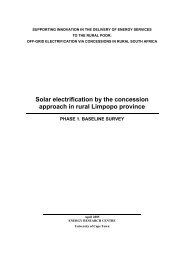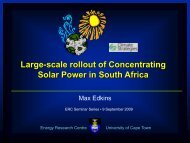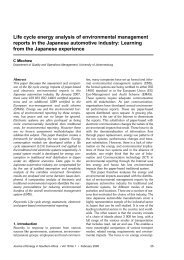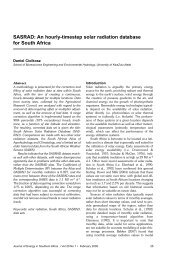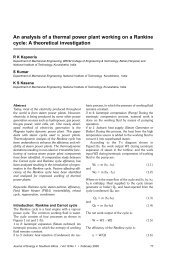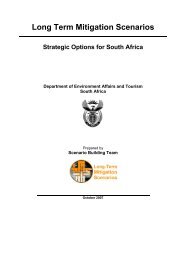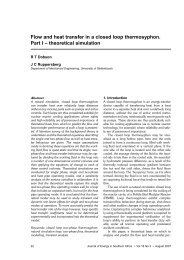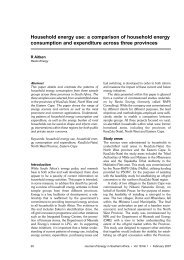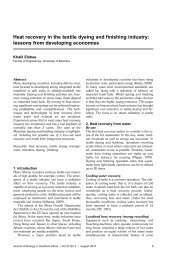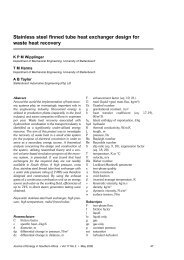Climate variability, climate change and water resource strategies for ...
Climate variability, climate change and water resource strategies for ...
Climate variability, climate change and water resource strategies for ...
You also want an ePaper? Increase the reach of your titles
YUMPU automatically turns print PDFs into web optimized ePapers that Google loves.
<strong>Climate</strong> <strong>variability</strong>, <strong>climate</strong> <strong>change</strong> <strong>and</strong> <strong>water</strong> <strong>resource</strong> <strong>strategies</strong> <strong>for</strong> small municipalities<br />
Critical<br />
Urgent<br />
Serious<br />
Table 5: Working classification of drought (DWAF Northern Cape 2005)<br />
Almost no <strong>water</strong> available. Water is being transported. Nearest <strong>water</strong> is more than 1km<br />
away.<br />
Water restrictions have been implemented. Expected to be critical in 2-3 months<br />
Water is available but <strong>resource</strong> is under stress. Water levels have dropped considerably.<br />
Expect to be urgent in 2-3 months<br />
3.2 Overview of Northern Cape dem<strong>and</strong><br />
The urban <strong>and</strong> rural domestic <strong>water</strong> requirements only make up 4% of the total dem<strong>and</strong>. The urban<br />
dem<strong>and</strong> is generally concentrated along the main stem Orange River as a result of agriculture or at<br />
places such as Port Nolloth <strong>and</strong> Springbok due to mining. The rural communities are widespread <strong>and</strong><br />
are mostly reliant on ground<strong>water</strong> (V3 Consulting & WRP 2002).<br />
In 2000, the Northern Cape Province supply versus dem<strong>and</strong> ratio illustrated the <strong>water</strong> vulnerability<br />
that exists in the province by effectively recording an undersupply of 8 million m 3 . If the supply <strong>and</strong><br />
dem<strong>and</strong> are projected to 2025, the <strong>water</strong> balance stays constant. This is mainly due to the<br />
demographic projections <strong>for</strong> this Water Management Area, which show a steady decline in<br />
population over the next 25 years (DWAF 2004b). Despite this documented <strong>water</strong> shortage, a<br />
survey of the small towns in the Northern Cape revealed that over 90% of the respondents stated that<br />
they understood there to be no limit on their dem<strong>and</strong> <strong>for</strong> <strong>water</strong> (Macroplan 2000).<br />
Table 6: Reconciliation of <strong>water</strong> requirements <strong>and</strong> availability <strong>for</strong> the year 2000<br />
(million m³/a) (DWAF 2004b)<br />
Component/<br />
Sub-area<br />
Local<br />
yield<br />
Transfers<br />
In 2<br />
Local<br />
requirements<br />
Transfers<br />
out<br />
Balance 1<br />
Orange ( 986) 2 035 989 60 0<br />
Orange Tributaries 22 0 31 0 ( 9)<br />
Orange Coastal 3 6 8 0 1<br />
Total <strong>for</strong> WMA ( 961) 2 035 1 028 54 ( 8)<br />
1. Brackets around numbers indicate a negative balance. Surpluses are shown in the most upstream<br />
sub-area where they first become available.<br />
2. Transfers into <strong>and</strong> out of sub-areas may include transfers between sub-areas as well as transfers<br />
between WMAs. The addition of the quantities transferred per sub-area does there<strong>for</strong>e not<br />
necessarily correspond to total transfers into <strong>and</strong> out of the WMA.<br />
Table 7: Reconciliation of <strong>water</strong> requirements <strong>and</strong> availability <strong>for</strong> the year 2025 base<br />
scenario (million m³/a) (after DWAF 2004b)<br />
Component/<br />
Sub-area<br />
Local<br />
yield 1<br />
Transfers<br />
in<br />
Local<br />
requirements 2<br />
Transfers<br />
out<br />
Balance 3<br />
Potential <strong>for</strong><br />
development 4<br />
Orange ( 981) 2 082 1 042 60 ( 1) 150<br />
Orange<br />
Tributaries<br />
Orange<br />
Coastal<br />
22 0 29 0 ( 7) 0<br />
2 6 8 0 0 0<br />
Total <strong>for</strong> WMA ( 957) 2 088 1 079 60 ( 8) 150<br />
1. Based on existing infrastructure <strong>and</strong> infrastructure under construction in the year 2000. Also<br />
includes return flows resulting from a growth in requirements.<br />
2. Based on normal growth in <strong>water</strong> requirements as a result of population growth <strong>and</strong> general<br />
economic development. Includes a 4 000 ha increase in irrigated farming l<strong>and</strong> in the Orange subarea,<br />
which will require 60 million m³/a.<br />
3. Brackets around numbers indicate a negative balance.<br />
4. Based on construction of the Vioolsdrift Dam.<br />
8




